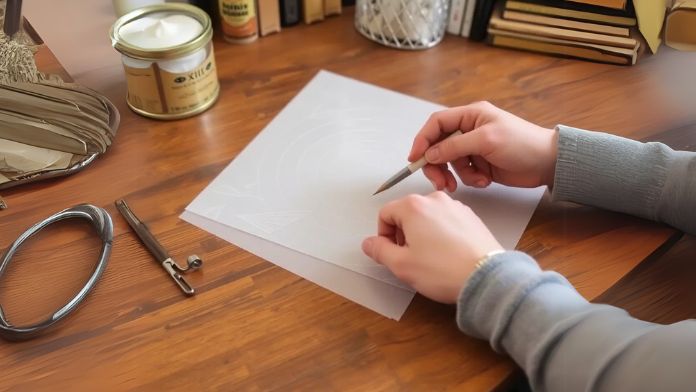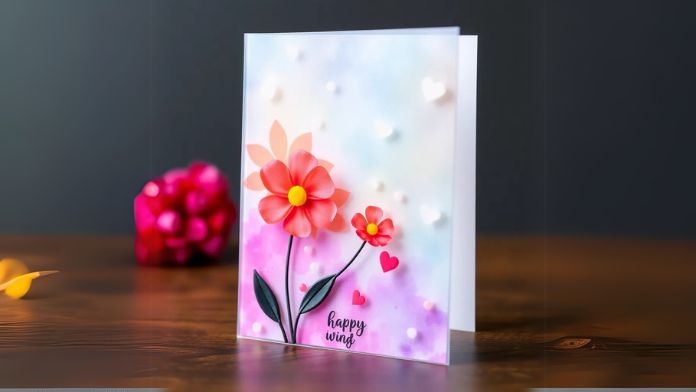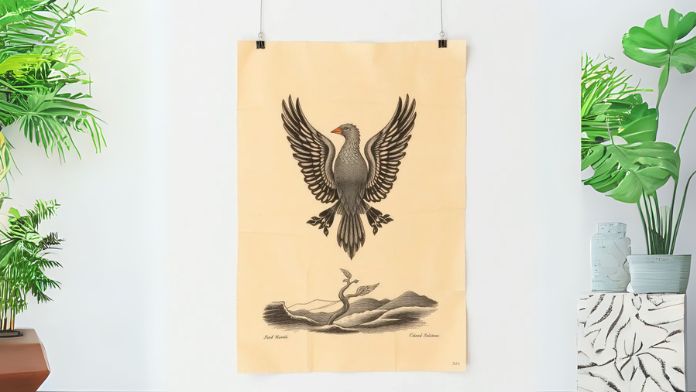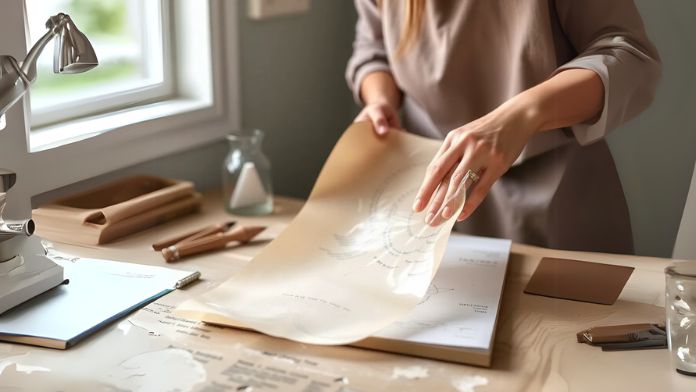If you’ve ever admired an elegant wedding invitation or a layered scrapbook design, chances are you’ve come across vellum paper. This translucent material adds sophistication and creativity to a variety of projects, making it a favorite among crafters and stationery enthusiasts. But how do you use vellum paper effectively? What makes it unique, and why should you consider adding it to your crafting arsenal?
In this guide, we’ll explore everything you need to know about vellum paper, from its properties and uses to creative ideas and practical tips. Whether you’re a seasoned crafter or a beginner, this article will help you make the most of translucent vellum sheets in your projects.
What Is Vellum Paper?
Vellum paper, often called translucent vellum paper, is a lightweight, semi-transparent material with a smooth surface. Originally, “vellum” was a type of calfskin parchment. However, modern vellum paper is typically made from cellulose fibers, making it both animal-free and versatile for crafting.
Its translucent quality sets it apart from regular paper, creating a frosted or glassine effect that adds depth and interest to designs. People might ask, “What is the translucent paper in papercraft called?” The answer is often vellum paper!
What Is Vellum Paper Used For?
Vellum paper has a wide range of applications across different creative fields. Here are some popular uses:

Wedding Invitations and Stationery
Vellum overlays are commonly used in wedding invitations to add elegance. Placed over printed text or designs, they create a layered, dreamy look. You can also use vellum to create envelope liners, RSVP cards, or menu designs.
Scrapbooking and Cardmaking
Crafters love translucent vellum sheets because they can soften bold colors or patterns. They’re perfect for layering, adding text, or creating decorative elements in scrapbooks or handmade cards.
Printing Projects
Printing on vellum can elevate any design, from certificates to event programs. It offers a luxurious touch when used as a translucent cover for printed materials.
Art and Mixed Media
Artists often incorporate vellum into mixed media projects, such as collages and sketches. Its translucent property allows for creative overlays and unique textures.
Gift Wrapping
Vellum sheets can serve as chic wrapping material for small gifts or as part of decorative gift tags and labels.
How to Use Vellum Paper: Beginner Tips
Using vellum paper might feel intimidating at first because of its delicate and slick texture. However, with a few tips and tricks, you can master it in no time.
Printing on Vellum Paper
Printing on vellum can yield stunning results, but you’ll need to take special care:
- Use an inkjet or laser printer: Both can work, but inkjet printers are generally better for delicate designs.
- Adjust the settings: Choose a lightweight paper setting to avoid streaks.
- Let it dry completely: Ink takes longer to dry on vellum. Give it plenty of time to avoid smearing.
Cutting Vellum
A clean cut is crucial when working with vellum:
- Use a sharp craft knife or high-quality scissors for precision.
- Consider a paper trimmer for straight edges.
Adhering Vellum to Projects
One common question is how to attach the vellum without the adhesive showing. Here are a few methods:
- Double-sided tape: Use it sparingly along the edges.
- Glue dots or vellum adhesives: These are specially designed to be less visible.
- Stitching or brads: For a decorative touch, sew vellum to your project or secure it with brads.
Layering with Vellum
Vellum is all about creating visual interest:
- Layer it over bold patterns to tone them down.
- Use it as an overlay for photos or text.
- Experiment with shapes and cutouts for dynamic designs.
Creative Ideas for Using Translucent Vellum Sheets

DIY Greeting Cards
Elevate your greeting cards with vellum accents. Stamp or print a design on vellum and overlay it on cardstock for a professional finish.
Luminaries and Candle Holders
Wrap the vellum around a glass jar to create a soft, glowing luminary. For an extra touch, you can add cutout designs.
Custom Gift Tags
Cut vellum into tag shapes and layer them with colored paper for stylish gift tags. Write directly on the vellum or use stamps for added charm.
Envelopes and Envelope Liners
Add a touch of luxury to envelopes by using vellum as liners or as translucent outer envelopes.
Photo Overlays
In scrapbooking, vellum can be used as a soft overlay for photographs, giving them a vintage or dreamy feel.
Advanced Techniques: Taking Vellum to the Next Level
Once you’ve mastered the basics, try these advanced techniques:
Heat Embossing on Vellum
Heat embossing adds texture and shine to vellum designs. To achieve a raised effect, stamp a pattern with embossing ink, sprinkle embossing powder, and heat-set it.
Watercolor Effects
Use water-based markers or diluted watercolor paints to create subtle backgrounds on vellum. Remember to let the paper dry completely to avoid warping.
Die-Cutting and Stamping
Die-cutting machines work well with vellum, allowing you to create intricate shapes. Stamping on vellum also works beautifully, especially with pigment ink.
General Print Tips for Vellum

- Vellum is not inexpensive, so always proofread for spelling and punctuation before you print.
- Let the ink dry before you touch it, or you will smear it. The drawback to using this type of paper is the time it takes to dry. But if you have patience, you will be pleased with the results.
- Allow a one-inch margin around your text to allow the rollers of your printer to grab the paper.
- Increase the spacing between letters so that the print does not smear.
- Carefully Lift each page as it finishes, and set it aside to dry.
- Print small batches of vellum with brakes in between batches. As the printer gets used, just like you, it needs a break to work at peak performance.
Why Choose Vellum Paper For Your Projects?
If you’ve ever wondered, “what is a vellum paper, and why should I use it?” the answer lies in its remarkable versatility. Vellum paper is a unique, semi-transparent material that brings elegance and creativity to various projects. Whether you’re a crafter, artist, or stationery enthusiast, it’s a must-have addition to your toolkit.
One of vellum’s standout qualities is its ability to add sophistication to any project. Its smooth, frosted texture makes it perfect for wedding invitations, gift tags, and decorative overlays. Vellum is also an excellent choice for layering, allowing you to soften bold patterns or create depth in your designs.
What makes vellum truly versatile is its compatibility with various media. You can print delicate designs, emboss intricate patterns, or experiment with watercolors and stamping for unique effects. Its translucent quality enhances light and texture, making it ideal for projects like luminaries, photo overlays, and mixed media art.
Whether creating something simple or intricate, vellum paper offers endless possibilities. Its ability to combine beauty and functionality ensures your creations will stand out, making it a valuable tool for unleashing your creativity.
Common Challenges and How to Overcome Them
Working with vellum paper can present a few challenges, but with the right techniques, you can easily overcome them and create stunning projects. Here are some common issues and their solutions:
Curling or Warping
Vellum is sensitive to moisture and temperature, which can cause it to curl or warp. Store your vellum sheets flat in a dry, cool environment to prevent this. Avoid placing them near heat sources or in humid areas. If curling occurs, gently flatten the paper under a heavy book or use a low-heat iron with a protective sheet over the vellum.
Visibility of Adhesive
Because of its translucent nature, adhesives can often show through vellum, disrupting the design. To solve this, experiment with specialized vellum adhesives or use double-sided tape sparingly along the edges. Secure vellum with brads, eyelets, or stitching for a decorative alternative. These hold the paper in place and enhance the overall look.
Smudging Ink
Due to its smooth surface, ink can take longer to dry on vellum. After printing or stamping, allow the design to dry completely before handling it. To speed up drying, use a heat gun on a low setting, keeping it at a safe distance to avoid warping.
Final Thoughts
So, how do you use vellum paper effectively? The key lies in understanding its unique qualities and experimenting with various techniques. Whether you’re creating wedding stationery, crafting a scrapbook, or designing DIY projects, translucent vellum sheets offer endless possibilities for creativity.
Now that you know what is vellum, it’s time to explore its potential. Gather your materials, let your imagination run wild, and elevate your crafting game with this versatile, elegant paper.
FAQ
Which Side of the Vellum Do You Draw on?
Technically speaking, vellum has a more absorbent side and a less absorbent side. To spot the difference, slightly wet your forefinger and thumb, then press the vellum between your fingers. The vellum should stick to one finger, and not the other, and the stickier side is the one you should print on.
What is The Purpose of Vellum?
Jewish scrolls, especially those of the Torah, as well as opulent bookbinding, memorial books, and other calligraphy manuscripts are still bound with vellum. Even though synthetic skins are now more widely utilized, it is still employed on instruments like the bodhran and banjo.
How Do You Apply Vellum?
With vellum, you paint in layers. You add one layer of color, wait for it to dry, and then add another. Move from light to dark colors, and slowly move your brush over the vellum to prevent smearing and paint blobs. Use the brush your painting requires.

